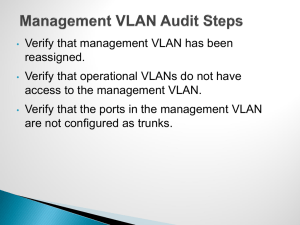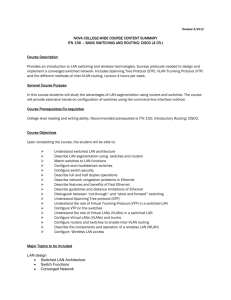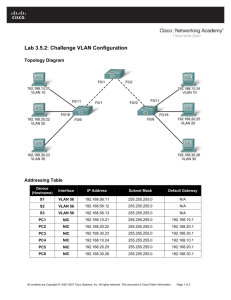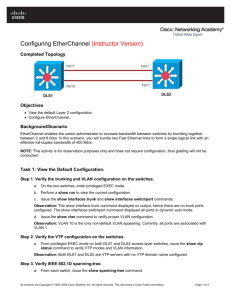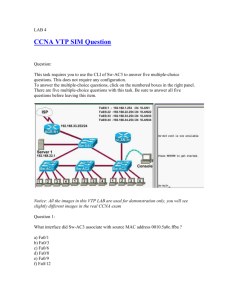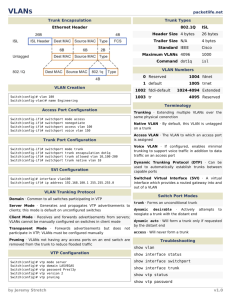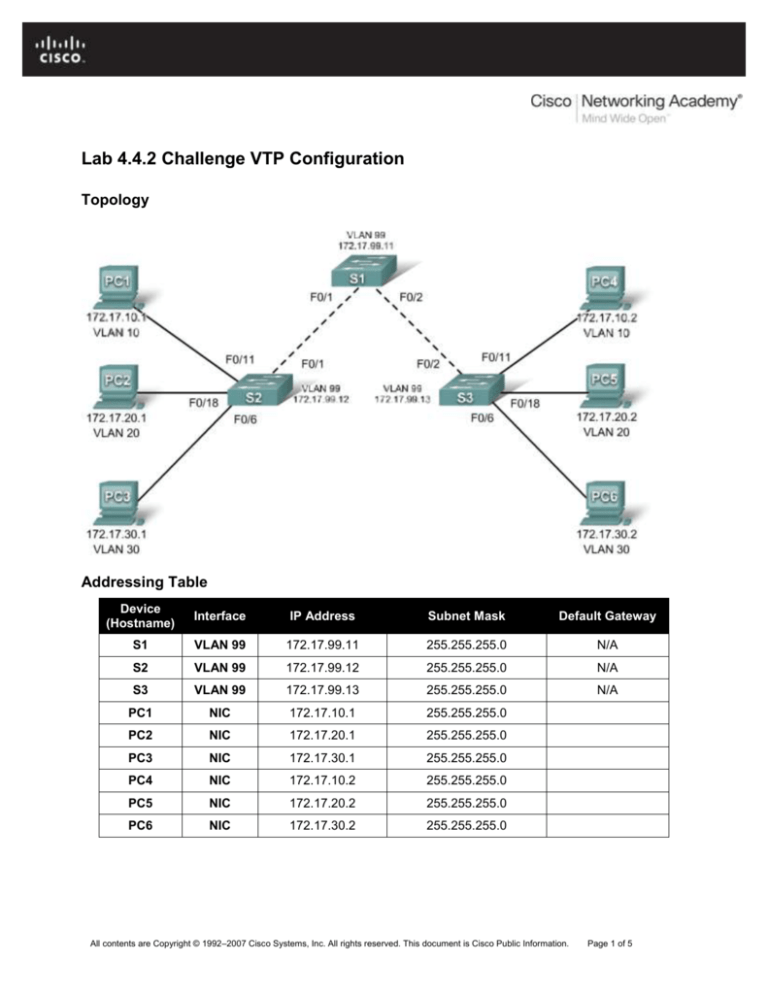
Lab 4.4.2 Challenge VTP Configuration
Topology
Addressing Table
Device
(Hostname)
Interface
IP Address
Subnet Mask
Default Gateway
S1
VLAN 99
172.17.99.11
255.255.255.0
N/A
S2
VLAN 99
172.17.99.12
255.255.255.0
N/A
S3
VLAN 99
172.17.99.13
255.255.255.0
N/A
PC1
NIC
172.17.10.1
255.255.255.0
PC2
NIC
172.17.20.1
255.255.255.0
PC3
NIC
172.17.30.1
255.255.255.0
PC4
NIC
172.17.10.2
255.255.255.0
PC5
NIC
172.17.20.2
255.255.255.0
PC6
NIC
172.17.30.2
255.255.255.0
All contents are Copyright © 1992–2007 Cisco Systems, Inc. All rights reserved. This document is Cisco Public Information.
Page 1 of 5
CCNA Exploration
LAN Switching and Wireless: VTP
Lab 4.4.2: Challenge VTP Configuration
Port Assignments (Switches 2 and 3)
Ports
Fa0/1 – 0/5
Fa0/11 – 0/17
Fa0/18 – 0/24
Fa0/6 – 0/10
None
Assignment
802.1q Trunks
VLAN 10 – engineering
VLAN 20 – sales
VLAN 30 – administration
VLAN 99 – network management
Network
172.17.10.0 /24
172.17.20.0 /24
172.17.30.0 /24
172.17.99.0 /24
Learning Objectives
Upon completion of this lab, you will be able to:
Cable a network according to the topology diagram.
Erase the startup configuration and reload a switch to the default state.
Perform basic configuration tasks on a switch.
Configure VLAN Trunking Protocol (VTP) on all switches.
Enable trunking on inter-switch connections.
Verify trunk configuration.
Modify VTP modes and observe the impact.
Create VLANs on the VTP server, and distribute this VLAN information to switches in the
network.
Explain the differences in operation between VTP transparent mode, server mode, and client
mode.
Assign switch ports to the VLANs.
Save the VLAN configuration.
Task 1: Prepare the Network
Step 1: Cable a network that is similar to the one in the topology diagram.
You can use any current switch in your lab as long as it has the required interfaces shown in the topology
diagram. The output shown in this lab is based on 2960 switches. Other switch types may produce
different output. If you are using older switches, then some commands may be different or unavailable.
Set up console connections to all three switches.
Step 2: Clear any existing configurations on the switches.
Erase existing configurations, VLANs, and reload the switch. Use the show vlan command to confirm
that only default VLANs exist and that all ports are assigned to VLAN 1.
Step 3: Disable all ports by using the shutdown command.
Task 2: Perform Basic Switch Configurations.
Step 1: Complete basic configuration of switches S1, S2, and S3.
Configure the S1, S2, and S3 switches according to the following guidelines and save all your
configurations:
All contents are Copyright © 1992–2007 Cisco Systems, Inc. All rights reserved. This document is Cisco Public Information.
Page 2 of 5
CCNA Exploration
LAN Switching and Wireless: VTP
Lab 4.4.2: Challenge VTP Configuration
Configure the switch hostname as indicated on the topology.
Disable DNS lookup.
Configure an EXEC mode password of class.
Configure a password of cisco for console connections.
Configure a password of cisco for vty connections.
Save running-configuration to startup-configuration.
Step 2: Re-enable the user ports on S2 and S3 and put those ports in access mode. Refer to the
topology diagram to determine which ports are connected to end-user devices.
Task 3: Configure the Ethernet Interfaces on the Host PCs
Configure the Ethernet interfaces of PC1 through PC6 with the IP addresses indicated in the addressing
table at the beginning of the lab.
Task 4: Configure VTP on the Switches
VTP allows the network administrator to control the instances of VLANs on the network by creating VTP
domains. Within each VTP domain, one or more switches are configured as VTP servers. VLANs are then
created on the VTP server and pushed to the other switches in the domain. Common VTP configuration
tasks are operating mode, domain, and password. In this lab, you will be configuring S1 as a VTP server,
with S2 and S3 configured as VTP clients.
Step 1: Check the current VTP settings on the three switches.
What is the current (default) VTP operating mode on the switches? _______________
What is the configuration revision on S1 and S2? _____________________
Step 2: Configure the operating mode, the domain name, and VTP password on all three switches.
Set the VTP domain name to access and the VTP password to lab4 on all three switches. Configure S1
in server mode, and S2 and S3 in client mode.
Note: The VTP domain name can be learned by a client switch from a server switch, but only if the client
switch domain is in the null state. It does not learn a new name if one has been previously set. For that
reason, it is good practice to manually configure the domain name on all switches to ensure that the
domain name is configured correctly. Switches in different VTP domains do not exchange VLAN
information. Recall that VTP domain names and passwords are case-sensitive.
Step 3: Configure trunking and the native VLAN for the trunking ports on all three switches.
Configure ports Fa0/1 through Fa0/5 in trunking mode. Configure VLAN 99 as the native VLAN for these
trunks. You can use the interface range command to simplify this task. Do not forget to enable the trunk
interfaces.
Step 4: Configure port security on the S2 and S3 access ports.
Configure ports Fa0/6, Fa0/11, and Fa0/18 on S2 and S3 so that they allow a maximum of two hosts to
connect to these ports and learn the MAC addresses of the hosts dynamically.
Step 5: Configure VLANs on the VTP server.
There are four VLANS required in this lab:
All contents are Copyright © 1992–2007 Cisco Systems, Inc. All rights reserved. This document is Cisco Public Information.
Page 3 of 5
CCNA Exploration
LAN Switching and Wireless: VTP
Lab 4.4.2: Challenge VTP Configuration
1. VLAN 99 (network management)
2. VLAN 10(engineering)
3. VLAN 20 (sales)
4. VLAN 30 (administration)
Configure these VLANs only on the VTP server.
When you are done, verify that all four VLANs have been created on S1.
Step 6: Check if the VLANs created on S1 have been distributed to S2 and S3.
Use the show vlan brief command on S2 and S3 to determine if the VTP server has pushed its VLAN
configuration to all these switches.
Are the same VLANs configured on all switches? ________________________
Explain why S2 and S3 have the same VLAN configurations at this point. ________________________
___________________________________________________________________________________
___________________________________________________________________________________
Step 7: Configure the management interface address on all three switches according to the
addressing table at the beginning of the lab.
Assign these addresses to the network management VLAN (VLAN 99).
Verify that the switches are correctly configured by pinging between them. From S1, ping the
management interface on S2 and S3. From S2, ping the management interface on S3.
Were the pings successful? ___________________________________________
If not, troubleshoot the switch configurations and resolve.
Step 8: Assign switch ports to VLANs.
Refer to the port assignment table at the beginning of the lab to assign ports to VLANs. Use the interface
range command to simplify this task. Note that port assignments are not configured through VTP. Port
assignments must be configured on each switch manually or dynamically using a VMPS server. Save the
configuration when you are done.
Step 9: Verify that the trunks are operating correctly.
From PC1, attempt to ping PC4, PC5, and PC6.
Were any of the pings successful? __________
Why did some of the pings fail? _______________________________________________________
_________________________________________________________________________________
Which hosts could be reached from PC3? ___________________________
Task 5: Configure VTP Pruning on the Switches
VTP pruning allows a VTP server to suppress IP broadcast traffic for specific VLANs to switches that do
not have any ports in that VLAN. By default, all unknown unicasts and broadcasts in a VLAN are flooded
over the entire VLAN. All switches in the network receive all broadcasts, even in situations in which few
users are connected in that VLAN. VTP pruning eliminates or prunes this unnecessary traffic. Pruning
saves LAN bandwidth because broadcasts do not have to be sent to switches that do not need them.
All contents are Copyright © 1992–2007 Cisco Systems, Inc. All rights reserved. This document is Cisco Public Information.
Page 4 of 5
CCNA Exploration
LAN Switching and Wireless: VTP
Lab 4.4.2: Challenge VTP Configuration
Configure pruning on the server switch, which is then pushed to client switches.
Confirm the VTP pruning configuration on each switch using the show vtp status command. VTP
pruning mode should show “Enabled” on each switch.
Task 6: Clean Up
Erase the configurations and reload the switches. Disconnect and store the cabling. For PC hosts that are
normally connected to other networks (such as the school LAN or to the Internet), reconnect the
appropriate cabling and restore the TCP/IP settings.
All contents are Copyright © 1992–2007 Cisco Systems, Inc. All rights reserved. This document is Cisco Public Information.
Page 5 of 5

